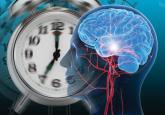NASHVILLE—Severity of white matter disease is an independent predictor of long-term full recovery in patients with mild acute ischemic stroke, researchers reported at the 2015 International Stroke Conference. Additionally, data indicate that IV t-PA treatment should not be precluded in such patients based on white matter disease burden.
White matter disease has been implicated in tissue and clinical outcomes of patients with acute ischemic stroke, and data link white matter disease burden measured semiquantitatively and functional dependence or death in patients with spontaneous primary brain hemorrhage, according to the investigators.
Researchers from Massachusetts General Hospital and Brown University sought to assess whether white matter disease burden may predict outcome in patients with mild acute ischemic stroke, a group that often has worse functional outcomes than expected. Lead author Pedro T. Cougo-Pinto, MD, Research Fellow at JP Kistler Stroke Research Center at Massachusetts General Hospital in Boston, and colleagues selected 465 patients with an NIH Stroke Scale (NIHSS) score less than 8 and acute brain ischemia on diffusion-weighted MRI. Patients were selected from a hospital-based, prospective acute ischemic stroke cohort. Researchers obtained normalized white matter hyperintensity volumes using a validated, semiautomated volumetric measurement tool and performed bivariate and multivariate regression analyses to identify independent predictors of full recovery on follow-up modified Rankin Scale (mRS) score at 90 days.
Hyperintensity Volume and Persistence of Symptoms Of the 465 patients, 128 (33%) achieved full recovery (ie, mRS score of 0). On bivariate analysis, greater normalized white matter hyperintensity volume and admission NIHSS score, as well as hypertension, diabetes, hyperlipidemia, and prior stroke, were associated with long-term persistence of symptoms, researchers said. In multivariable analysis, the odds of favorable outcome were independently decreased by higher admission NIHSS score (odds ratio [OR], 0.83), history of diabetes (OR, 0.46) and prior stroke (OR, 0.3), as well as increasing quartiles of normalized white matter hyperintensity volume (OR, 0.48).
“In our sample, the odds of full recovery long-term were significantly reduced among the individuals with the highest volume of white matter hyperintensity (12–84 cm3). Among this subset, only 21% of patients had full recovery,” said Natalia S. Rost, MD, MPH, FAAN, Director of Acute Stroke Services at Massachusetts General Hospital and Associate Professor of Neurology at Harvard Medical School in Boston, the study’s senior author.
Future Opportunities to Personalize Acute Stroke Care
Normalized white matter hyperintensity volume demonstrated no interaction with IV t-PA treatment, which was received by 29 (6%) of the patients. Patients with mild stroke may often be denied IV t-PA because the treatment may be perceived to be too aggressive for the patients’ mild symptoms. These data, however, hint that IV t-PA should not be withheld, at least on the basis of white matter disease severity, researchers said. Furthermore, these findings indicate that normalized white matter hyperintensity volume “might be a useful tool for prognostic stratification and to gauge therapeutic intervention in this challenging population,” Dr. Cougo-Pinto and colleagues said.
“Because white matter disease burden is a pre-existing condition that is often diagnosed at the time of stroke, no established intervention exists to specifically target outcomes in this patient population,” said Dr. Rost. “This [situation] is further complicated by the fact that the actual mechanisms by which white matter disease contributes to the lower odds of good outcome is not known. Among some working hypotheses are diffusely altered mechanisms of microvascular perfusion during acute ischemia, as well as dysfunctional neuronal networks in patients with a large burden of disease. Therefore, future interventions to improve outcomes in this patient population will need to focus on improvement of cerebral tissue perfusion during acute ischemia, as well as reinforcing mechanisms of early recovery through early, aggressive personalized rehabilitation strategies.”
